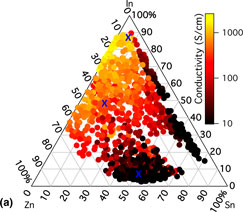Crossref Citations
This article has been cited by the following publications. This list is generated based on data provided by
Crossref.
Medvedeva, Julia E.
Buchholz, D. Bruce
and
Chang, Robert P. H.
2017.
Recent Advances in Understanding the Structure and Properties of Amorphous Oxide Semiconductors.
Advanced Electronic Materials,
Vol. 3,
Issue. 9,
Talley, Kevin R.
Bauers, Sage R.
Melamed, Celeste L.
Papac, Meagan C.
Heinselman, Karen N.
Khan, Imran
Roberts, Dennice M.
Jacobson, Valerie
Mis, Allison
Brennecka, Geoff L.
Perkins, John D.
and
Zakutayev, Andriy
2019.
COMBIgor: Data-Analysis Package for Combinatorial Materials Science.
ACS Combinatorial Science,
Vol. 21,
Issue. 7,
p.
537.
Brito, Pedro P.
Diniz, Antonia Sonia A.C.
and
Kazmerski, Lawrence L.
2019.
Materials design and discovery: Potential for application to soiling mitigation in photovoltaic systems.
Solar Energy,
Vol. 183,
Issue. ,
p.
791.
Hattrick-Simpers, Jason R.
Zakutayev, Andriy
Barron, Sara C.
Trautt, Zachary T.
Nguyen, Nam
Choudhary, Kamal
DeCost, Brian
Phillips, Caleb
Kusne, A. Gilad
Yi, Feng
Mehta, Apurva
Takeuchi, Ichiro
Perkins, John D.
and
Green, Martin L.
2019.
An Inter-Laboratory Study of Zn–Sn–Ti–O Thin Films using High-Throughput Experimental Methods.
ACS Combinatorial Science,
Vol. 21,
Issue. 5,
p.
350.
Li, Ke-Ding
and
Chang, Kao-Shuo
2020.
Effects of Zn Ratio Tuning on the Structural and Transport Properties of Amorphous Indium Zinc Tin Oxide Thin Films.
Journal of Electronic Materials,
Vol. 49,
Issue. 12,
p.
7336.
Jain, Neeraj
Sharma, Shashi Kant
and
Kumawat, Renu
2022.
a-ITZO based thin film transistor for ammonia gas sensing: a simulation study.
Engineering Research Express,
Vol. 4,
Issue. 4,
p.
045032.
Fonoll-Rubio, Robert
Becerril-Romero, Ignacio
Vidal-Fuentes, Pedro
Grau-Luque, Enric
Atlan, Fabien
Perez-Rodriguez, Alejandro
Izquierdo-Roca, Victor
and
Guc, Maxim
2022.
Combinatorial Analysis Methodologies for Accelerated Research: The Case of Chalcogenide Thin‐Film Photovoltaic Technologies.
Solar RRL,
Vol. 6,
Issue. 9,
Bonilla, Ruy Sebastian
2022.
Modelling of Kelvin probe surface voltage and photovoltage in dielectric-semiconductor interfaces.
Materials Research Express,
Vol. 9,
Issue. 8,
p.
085901.
Can, Hilal Aybike
Öztürk, Tayfur
and
Akyıldız, Hasan
2022.
A combinatorial study on ZnO-In2O3-SnO2 system: The effects of different postgrowth annealing conditions on optical and electrical properties.
Journal of Alloys and Compounds,
Vol. 924,
Issue. ,
p.
166591.
Jung, Taeseung
and
Jeon, Sanghun
2022.
Effects of iCVD organic passivation in oxide thin-film transistors under repetitive bending stress for electrical and mechanical stability.
Journal of Vacuum Science & Technology B,
Vol. 40,
Issue. 4,
Can, Hilal Aybike
Öztürk, Tayfur
and
Akyıldız, Hasan
2023.
Effect of deposition parameters on optical and electrical properties of ZnO–In2O3–SnO2 thin films.
Materials Chemistry and Physics,
Vol. 296,
Issue. ,
p.
127256.
Li, Siang-Yun
Shen, Yun-Hwei
Chang, Kao-Shuo
Wu, Wan-Yu
and
Ting, Jyh-Ming
2023.
Exploring Zn–Sn–O (ZTO) composition spreads with combinatorial sputtering.
Applied Physics A,
Vol. 129,
Issue. 5,
Oh, Injong
Kim, Hojang
Son, Hansol
Nam, Seungjin
Choi, Hyunjoo
and
Sim, Gi-Dong
2023.
Combinatorial experiments for discovering Al-C thin films with high strength and ductility.
International Journal of Plasticity,
Vol. 161,
Issue. ,
p.
103515.






